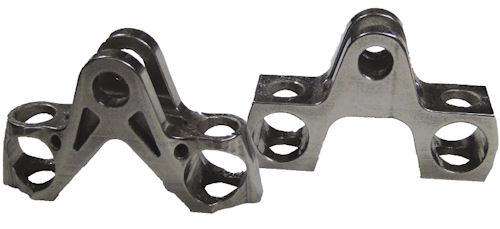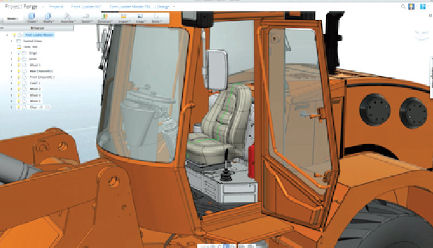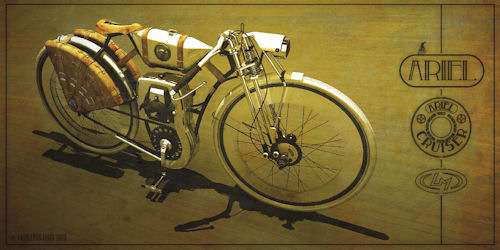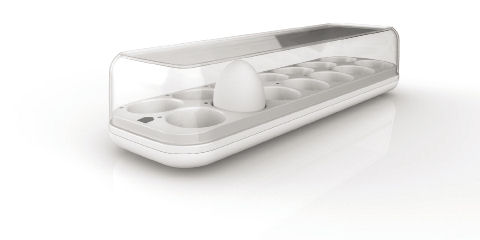Crowdsourcing Power to the People
Companies are experimenting with crowdsourcing and open innovation approaches to accelerate the flow of new product ideas -- and to get faster and better answers to tough engineering questions.
Latest News
September 1, 2013
 As part of its 3D Printing Production Quest, GE is challenging the crowd to create an aircraft engine bracket using additive technologies. Image courtesy of General Electric. |
The company established the Sparks Innovation Center—what it dubs its new product incubator—to solicit ideas from working electricians to solve the challenges they face regularly on the job. The idea for the innovation community came from a chance encounter at a trade show, where Madison Electric Products President Brad Wiandt happened upon a product created by a licensed electrician who wasn’t fully committed to seeing it through manufacturing and production. The two hammered out a licensing deal, and a door opened for Madison Electric to formalize an approach that would help with the ideation of novel products.
“We wanted to transition our business to the next level, and we needed a reason to get new customers to look at us. New products was the hook,” Wiandt explains. “Yet we were very lean in the area of engineering and product development—and we realized there’s a lot of great ideas out there. We just had to connect to the contractors and users on the jobsites to get to those ideas.”
 Companies like Peterbilt and BMW are turning to Local Motors to leverage its FORGE collaboration platform as part of their own crowdsourcing efforts. Image courtesy of Local Motors. |
The relatively small Madison Electric is on to a new product innovation strategy that is in the experimental phase at a growing number of big manufacturers, including General Electric, Philips North America, BMW and even the U.S. Department of Defense. These traditional players, in the company of new upstarts like Quirky and Local Motors, are harnessing the collective wisdom of the crowd for everything from design ideation to the co-creation of products to getting answers to tough engineering questions.
While not necessarily new, the practice of crowdsourcing is being reinvented thanks to the arrival of new social networking, visualization and Web 2.0 technologies. Moreover, interest in crowdsourcing is on the rise today, given ongoing competitive pressures and as companies look to be more customer-driven while reducing time-to-delivery cycles for new products.
“If you can leverage a broader group of experts that are not inside your four walls, as well as creativity not bound by typical corporate processes, and include users in that process, you can drive that customer orientation,” says Karsten Newbury, senior vice president and general manager for mainstream engineering software at Siemens PLM Software. While crowdsourcing as a product development and engineering strategy is still relatively unproven, Newbury says it’s turned the corner in terms of being taken more seriously.
 Ianis Vasilatos of Romania took first place and a $2,000 cash prize in Local Motors’ Cruiser Design Challenge, a crowdsourcing effort to create the company’s first motorized bicycle. Image courtesy of Local Motors. |
“What’s exciting is there are a number of serious players looking at this, not just as a fun activity or as a way to get a nice product name or conceptual design, but as a real innovation tool,” he says. “Nevertheless, it’s still going to take several years to see how manufacturers should best leverage it and make it a core component of their process.”
Testing the Waters
Competitions have become the proving ground for crowdsourcing’s potential. Take Philips North America, for example. Through its recently announced Innovation Fellows competition, the company is tasking innovators to submit their ideas for future innovations aimed at improving people’s everyday lives, specifically in the areas of living well, being healthy and enjoying life. Entrants to the contest have a shot at winning $100,000 in prize money from Philips North America, and the company is also encouraging participants to garner more financial support for their ideas on Indiegogo.com, a global crowdfunding site.
“By focusing the Innovation Fellows competition toward the priority areas identified through the Philips Meaningful Innovation Index, we can continue to pioneer and foster products, services and game-changing innovations that will help people, communities, healthcare systems, governments and future generations address the critical issues surrounding how we live, how content we are, and our own roles in those dimensions of our lives,” says Greg Sebasky, chairman of Philips North America.
Sebasky says the crowdsourcing model can work at any stage of development, but it’s particularly useful for early ideation. “Crowdsourcing is valuable from an idea-generating standpoint, because many people are developing ideas that personally matter to their lives,” he explains. “The method encourages the generation of new ideas to the market, but also allows individuals or smaller organizations to receive the proper funding and support they need to bring the product to life.”
General Electric (GE) is another industry behemoth experimenting with several variations on the crowdsourcing theme. In addition to its Ecoimagination Challenge to spark the best ideas around sustainability in areas like renewables, grid efficiency, and eco-friendly homes and buildings, the company has partnered with the Massachusetts Institute of Technology (MIT) and DARPA (Defense Advanced Research Projects Agency) to help create a crowdsourcing platform. The platform is aimed at enabling a global community of experts to rapidly design and manufacture complex systems such as military vehicles, aviation systems, and advanced medical devices—all of which can traditionally take decades to develop.
Along with those efforts, GE regularly hosts open engineering quests as part of its investment in advanced manufacturing. Most recently, the company launched two global additive manufacturing (AM) quests: one that invites participants to come up with a 3D-prinable design for an aircraft engine bracket, and the other to use 3D printing technology to produce highly precise and complex parts, potentially for medical imaging applications. GE has partnered with GrabCAD, an open CAD community, to launch the design quest and has taken on NineSigma as a partner on the 3D printing production quest.
 Egg Minder is one of several “connected home” products to be released as part of the Wink consumer line, which is a crowdsourcing partnership between Quirky and General Electric. Image courtesy of Quirky. |
According to Prabhjot Singh, Ph.D., manager of the Additive Manufacturing Lab at GE Global Research, the quests help GE stay connected with the latest technologies in the field—and are particularly useful for the discovery process. With AM, for example, GE is looking for designers who have experience and an eye toward designing shapes that weren’t possible with traditional manufacturing methods.
“We are looking for people not encumbered by more conventional forms of manufacturing,” he explains. “The thought process needs to be fresh, and to do so, we need to look outside of the company.”
Community-Driven Product Development
In yet another iteration of crowdsourcing, GE has partnered with Quirky, a consumer product innovation platform, to develop the Wink: Instantly Connected line of consumer products for the connected home. As part of the arrangement, GE is giving the Quirky inventor community access to thousands of its U.S. patents to use as a starting point for new designs. Among the treasure trove of patents at their disposal: optical systems, including holographic and fast-focusing lens technologies; barriers coatings; and telematics and asset tracking capabilities.
The Quirky community and innovation platform will serve as the genesis for co-creation, and the products selected for commercialization will start to be released later this year, says John Jacobsen, Quirky’s head of products. One early example of a possible Wink offering is the Egg Minder, an egg tray and corresponding app that alerts consumers to the number of eggs left in the tray, as well as their remaining shelf life. To date, more than 1,000 Quirky community influencers have participated in some way in the Egg Minder’s development, according to Quirky.
“Product development can no longer be done in a vacuum or in an ivory tower, and ideas are not necessarily formed in the boardroom—they’re formed in the living room or on the drive home,” Jacobsen says. “Companies are realizing they are not structured for it. They’re looking to partner with people who are.”
Local Motors, a global community focused on co-created vehicle design, is rapidly becoming a go-to crowdsourcing partner for entities from the U.S. government to corporate giants like BMW and Peterbilt. Its most prominent effort to date is its work with DARPA to enlist the crowd to help develop the XC2V Combat Support Vehicle, and its VehicleFORGE co-creation community is also being tapped to develop ideas for the Fast, Adaptable, Next-Generation Ground Vehicle (FANG). Local Motors’ co-creation approach was even cited by President Obama back in 2011 as an example of an innovation in manufacturing that could help facilitate faster and cheaper product development.
In addition to those high-profile DARPA projects, Local Motors uses the crowdsourcing model to generate ideas such as the development of its Rally Fighter vehicle—and more recently, for a motorized bicycle. The Local Motors FORGE community is also engaged on development projects with Peterbilt, to dream up the styling elements for its Road Icon Generation 2 (RIG2), for example, and with Domino’s Pizza to create the ultimate delivery vehicle, among other initiatives.
Alex Fiechter, Local Motors FORGE engineering community manager, contends that if implemented properly, a crowdsourcing approach can operate far more efficiently while generating better ideas than traditional development. But he notes that companies pursuing a crowdsourcing model do need to get a few things straight.
The most important thing is to understand the types of experts you are trying to attract, and structure the community so that it has value and motivates them to participate, he says. Companies also need to make all the necessary resources available to the crowd—CAD models, critical IP, specifications, part models, whatever it takes—so they can accomplish the task with which they’ve been charged.
“Crowdsourcing can really work at every stage of development,” Fiechter maintains. “But companies that want to leverage the crowd effectively need to do some growing in terms of their mindset, and be willing to give the crowd everything they need to get the job done. If you can’t come to grips with that, crowdsourcing is a non-starter right there.”
Beth Stackpole is a contributing editor to DE. You can reach her at [email protected].
More Info
Subscribe to our FREE magazine, FREE email newsletters or both!
Latest News
About the Author
Beth Stackpole is a contributing editor to Digital Engineering. Send e-mail about this article to [email protected].
Follow DE





